How to stop a bank crisis in 72 hours
By Jeff Stein, Tony Romm and Gerrit De Vynck
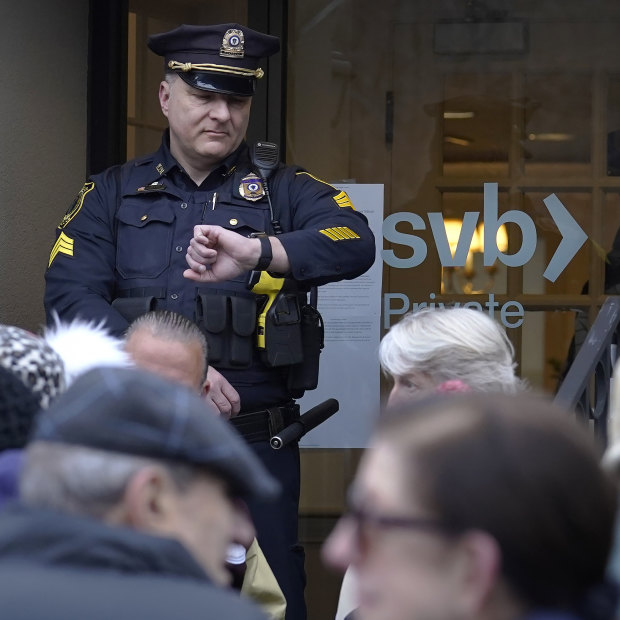
It seemed like a simple question: Did the US treasury secretary have any concerns about the economic risks posed by Silicon Valley Bank?
It was Friday morning, March 10, and a wave of public panic had started to spread about one of the tech industry’s leading financial institutions. Seated at the witness stand for a roughly three-hour grilling on Capitol Hill, Janet Yellen replied with a calm nod and a glance at her notes: “There are recent developments that concern a few banks that I’m monitoring very carefully,” she said.
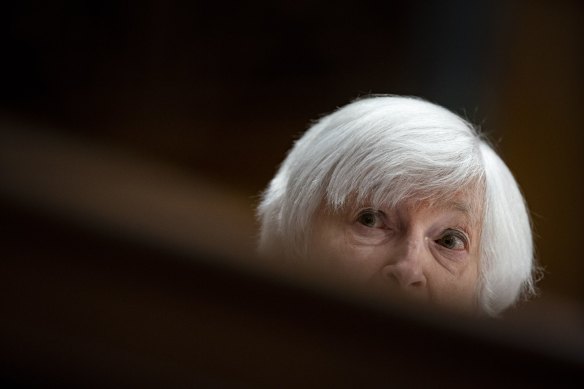
“When banks experience financial losses,” she added, “it is and should be a matter of concern.”
Yellen’s comments foreshadowed the start of a scramble behind the scenes at the White House. New fears began to surface about a potential run on Silicon Valley Bank, threatening widespread devastation not just for California, its companies and workers.
In a meeting, Jeff Zients, the chief of staff; Lael Brainard, the national economic director; and Cecilia Rouse, one of Biden’s top economic advisers, alerted the president to a type of danger not seen since the financial crisis nearly 15 years ago: The failure of Silicon Valley Bank, a little-known entity to most, could trigger a broader crisis in the banking system.
“We were already very focused on that when we spoke to the president Friday morning,” according to one White House official. “We were already alert to the potential this could lead to contagion and could implicate a series of what are pretty large banks.”
A frenetic, roughly 72-hour race soon unfolded in Washington to confront the threat of a full-blown financial meltdown. A bank was failing. Billions of dollars – in workers’ paychecks, and tech companies’ balance sheets – were about to be lost. And the government faced fears of an economy in free fall, rekindling nightmares of the Great Recession in 2008.
Ultimately, the Biden administration decided to complete a major intervention with extraordinary speed, acting to preserve deposits at Silicon Valley Bank while safeguarding the finances of other firms on the precipice of ruin. Their efforts showed the extent to which the president was willing to risk being accused of providing emergency help to bail out the financial sector – a charge the White House adamantly denies – in a bid to keep the system stable and stave off a worsening crisis.
This account is based on interviews with 20 people familiar with the decision-making process, including top White House officials, leading congressional lawmakers and tech industry executives. Many of them spoke on the condition of anonymity to describe private conversations that carried market-moving stakes.
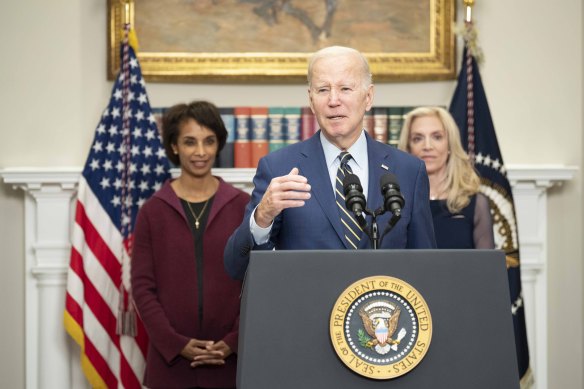
The administration had until Asian markets opened on Sunday to ensure that SVB customers could withdraw funds and businesses could pay their workers – all without sparking similar runs on other US banks. Top aides at banking regulators over the weekend spotted surges in requests for cash withdrawals at banks that didn’t appear to be connected to SVB, three sources said.
In the back of their minds, government officials recalled all too well the fallout from the 2008 financial crisis, and the immense political blowback that followed over the government’s use of taxpayer funds for what was widely seen as an unfair bailout. Over the weekend, they began to see banks outside of tech-heavy New York and California showing signs of volatility. Bank executives told federal officials that major customers had warned they would withdraw their money and move it to a Wall Street giant for safety first thing on Monday morning.
The Biden administration faced further pressure from Silicon Valley executives, including the co-founder of LinkedIn, as well as a wide array of influential California Democrats, such as former House speaker Nancy Pelosi. They amplified the urgent need for action when many financial analysts outside Washington remained unaware of how bad things could get.
Instead, the administration managed to calm markets, after a day of turbulence that cut deeply into banks’ stocks on Monday. And it prevented the sort of panic that might have resulted in countless Americans withdrawing money from their banks, which could have created damaging instability in the financial system.
“Within Treasury, there had been some initial concern about going too far in their response. By Saturday, the dynamic had shifted overwhelmingly in favour of doing something big,” said one person in direct communication with several senior Treasury officials, speaking on the condition of anonymity to describe private conversations. “They were becoming increasingly concerned about a bloodbath on Monday.”
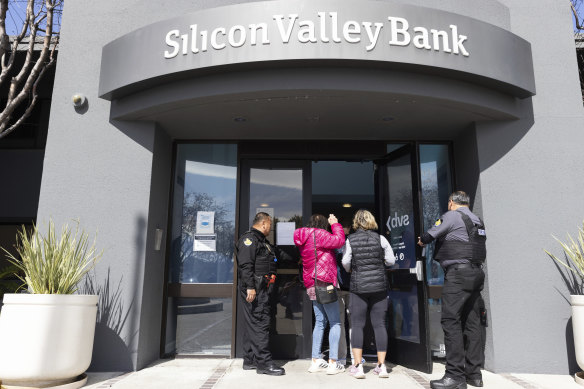
In the tech and venture capitalist circles that Silicon Valley Bank served, the anxiety had been mounting for days.
It began with a public notice March 8 that the firm had offloaded $US21 billion worth of securities and was moving to sell another $1.25 billion in its own stock to shore up its balance sheet. The news came as a surprise to many of SVB’s investors and customers. Moody’s Investor Services, an independent credit rating firm, downgraded SVB after reviewing the bank’s business.
By the evening, texts, calls and emails began bouncing between tech investors and start-up founders. The news travelled especially fast in the tight-knit Valley, where new companies often share the same stable of investors, said Isa Watson, the CEO of New York-based social media start-up Squad, which banked with Silicon Valley Bank.
Soon, federal policymakers and SVB’s customers alike were starting to worry about whether the bank would make it through the weekend. Around 9 am Eastern time on Thursday, Union Square Ventures emailed its portfolio companies to warn them about the situation, according to a person who received the email. USV is one of the most influential early-stage venture capital firms and was an early investor in Twitter, Etsy and Duolingo. Its portfolio includes dozens of start-ups, many of which banked with SVB.
Watson spoke to several investors, some of whom said to pull her company’s money out, while others cautioned not to make a rash decision, she said. She decided to wait. But many of Silicon Valley Bank’s customers did not. On Thursday alone, roughly $42 billion fled SVB accounts, according to California’s financial protection authority – a full-blown run on the bank.
Wall Street halted trading in SVB shares on Friday as its stock price plummeted. State and federal regulators moved to close the bank around noon Eastern time – 9 am at most of its branches – in a surprising development because it happened during normal business hours.
In the hours to follow, the extent of the problem became clear: Silicon Valley Bank held an unusually high percentage of its assets in Treasury bonds. When the Federal Reserve raised interest rates, the value of existing bonds – a normally safe asset – went down. So the bank could not sell those bonds easily to make good on customers’ deposits as panic set in, and many flooded the bank seeking to withdraw their funds.
Many of the bank’s customers, meanwhile, were not the usual fare – they were investors, companies and other large institutions. It had more than $170 billion in deposits by the end of December, but 90 per cent of them exceeded $250,000, the amount up to which the federal government insures in the event of a collapse.
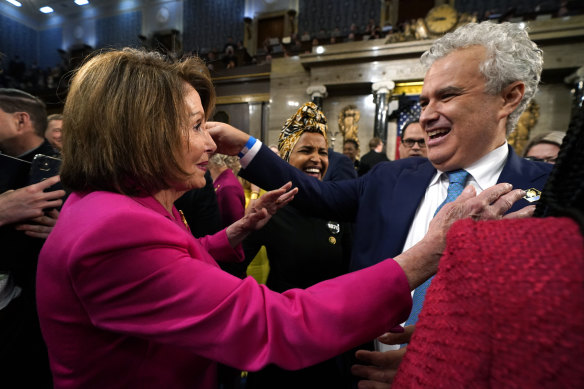
By Saturday, Yellen, Federal Reserve chair Jerome Powell, and Federal Deposit Insurance Corp. chairman Martin Gruenberg convened for the first of several emergency meetings that would lead to extraordinary action. They agreed to move forward to ensure bank depositors were protected – at no taxpayer expense – in a way that would ensure the payrolls of companies that had banked at SVB could operate normally by Monday. Otherwise, they feared a cascading set of consequences would leave many Americans out of work. They also determined to announce the plan before Asian markets opened on Sunday night.
Compounding the deadline, the Biden administration faced calls for urgent action from some of the biggest names in Silicon Valley, who wanted to see all depositors – regardless of their size – made whole.
Sounding alarms were the likes of Reid Hoffman, the founder of LinkedIn and a partner at Greylock, a major venture capital firm. A prolific donor to Democrats, including Biden, he took his concerns to Democratic lawmakers and administration officials. Ron Conway – another of the area’s leading investors, with original stakes in Airbnb, Facebook and Google – worked with Pelosi and Governor Gavin Newsom to put pressure on the White House, Treasury Department and elected officials.
More than 600 tech executives, engineers and investors piled onto a hastily arranged, late Friday call with congressman Ro Khanna, who represents a district that includes the headquarters for Silicon Valley Bank. Publicly, the Democrat soon emerged as a forceful voice calling for the Biden administration to rescue the bank’s depositors, warning about broader financial shocks to come.
The lobbying blitz reflected a broader sea change in the normally libertarian tech industry – one that typically tries to ward off federal intervention. Now, many of those same voices were calling on the Biden administration to act and protect an ecosystem in which they had a large stake.

Californian politicians, meanwhile, mounted their own pressure campaign in Zoom calls and other contacts with Biden administration officials. The collapse of SVB spooked many members, who recalled the devastation wrought by the financial crisis 15 years ago. They quickly began to hear an earful from voters, business owners and political donors, who feared the economic blow that the bank’s collapse could deliver to the tech-heavy state.
“When I went to do a little grocery shopping, I couldn’t help but notice a lot of people at the banks,” said congresswoman Anna Eshoo, whose Golden State district includes a portion of the tech industry, recalling her concerns over the weekend.
Maxine Waters, the top Democrat on the financial services committee, started raising the issue with then FDIC late Friday. Congresswoman Zoe Lofgren, who leads the California delegation, by Saturday evening organised the first of several meetings between a wider array of state lawmakers and federal banking regulators.
Initially, Democrats expressed their broad belief that the government, first and foremost, should try to secure the sale of Silicon Valley Bank. But as the potential dangers became more apparent of letting uninsured bank deposits evaporate, party lawmakers shifted toward trying to persuade the administration to take any action necessary to stave off crisis.
California members told administration officials stories of local businesses that stood to suffer in the event of a financial catastrophe, even beyond tech. In one example, they pointed to a payroll processor that parked its money at SVB and served nearly 1 million workers – people who could miss paychecks if large depositors weren’t rescued. Khanna, meanwhile, pointed to a local food bank that had relied on the now-failed firm.
The administration still faced obstacles to sweeping action. Biden had reservations about approving a plan that could be spun as a bailout for bank shareholders. Senator Bernie Sanders was publicly warning against a bailout.
The White House needed a plan that would not further alarm financial markets. SVB’s collapse was public, but few outside the government knew yet that Signature Bank – with more than $100 billion in assets – was heading towards failure too. Officials feared that Signature’s collapse on the heels of SVB’s could have a much greater ripple effect, and they wanted to make sure the news surfaced at the same time as the administration’s sweeping rescue plan.
Federal Reserve officials had access to the overnight filings of all the banks and their cash needs, giving them the ability to estimate their liquidity. The information was passed to the Treasury Department, with Yellen – a former Fed chair – serving as the key conduit between the central bank and political leadership at the White House.
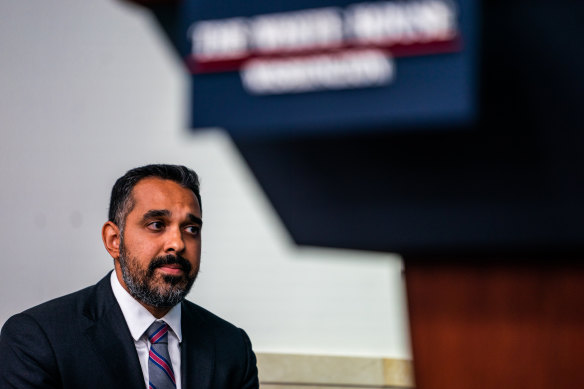
Inside the White House, responsibility for managing the crisis fell primarily to Zients, Brainard and White House Deputy National Economic Council Director Bharat Ramamurti. Brainard had only been on the job for weeks but was almost perfectly situated to respond to a banking crisis, having recently left the Fed after more than eight years.
Although administration officials had largely decided by Saturday night that all depositors must be protected, they also worried about how to ward off the perception that they were acting primarily to bail out the rich and well connected who had been pressing for help. The plan does not protect the SVB’s shareholders or executives.
“There was a lot of concern about: What is the messaging here?” said one person, who spoke on the condition of anonymity to describe private deliberations. “Are we just saving these rich people, or are we doing something to save the economy? How do we present that, and what do we demand in terms of accountability to make clear this is not favourable treatment for a select few?”
On Sunday afternoon, after Biden signed off on the plan, members of the FDIC and Federal Reserve boards voted unanimously to declare that the failure of SVB and Signature posed a systemic risk to the entire financial system. The Fed also announced a new mechanism to provide loans at favourable terms to banks under duress.
By Tuesday afternoon, the storm appeared to have calmed, and stock prices in the banking sector had stabilised. But tensions then shifted to Europe, where Credit Suisse stock plummeted on Wednesday after the 167-year-old giant bank disclosed problems related to its financial reporting, prompting Switzerland’s central bank to offer up to $54 billion in emergency loans. That intervention, along with Thursday’s rescue effort for First Republic, appeared to calm some fears.
But Friday trading shows that jitters remain. Major stock indexes slid – and the troubled First Republic Bank declined sharply, falling by more than 30 per cent despite a new $30 billion lifeline from big Wall Street firms.
“The weekend intervention dampened the immediate crisis,” said Bob Hockett, a Cornell University economist. “But continued rate hikes will simply bring more distress to industries – and thus to their banks – in the weeks and months to come.”
— with Jeanne Whalen and Julian Mark.
The Washington Post
The Business Briefing newsletter delivers major stories, exclusive coverage and expert opinion. Sign up to get it every weekday morning.
Most Viewed in Business
Source: Thanks smh.com